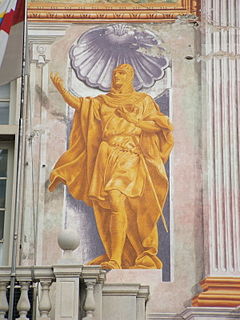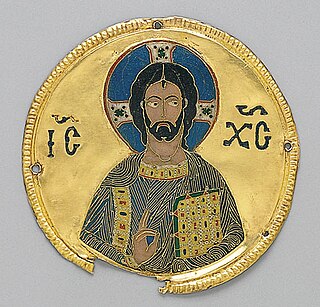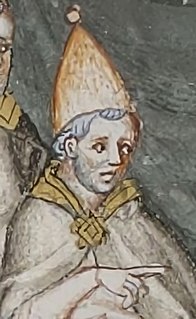Related Research Articles

Year 1102 (MCII) was a common year starting on Wednesday of the Julian calendar.

Pope Lucius III, born Ubaldo Allucingoli, reigned from 1 September 1181 to his death. Born of an aristocratic family of Lucca, prior to being elected pope, he had a long career as a papal diplomat. His papacy was marked by conflicts with Holy Roman Emperor Frederick I, his exile from Rome and the initial preparations for the Third Crusade.

Baldwin I, also known as Baldwin of Boulogne, was the first count of Edessa from 1098 to 1100, and king of Jerusalem from 1100 to his death. He was the youngest son of Eustace II, Count of Boulogne, and Ida of Lorraine and married a Norman noblewoman, Godehilde of Tosny. He received the County of Verdun in 1096, but he soon joined the crusader army of his brother Godfrey of Bouillon and became one of the most successful commanders of the First Crusade.

The Council of Clermont was a mixed synod of ecclesiastics and laymen of the Catholic Church, called by Pope Urban II and held from 17 to 27 November 1095 at Clermont, Auvergne, at the time part of the Duchy of Aquitaine.

Dagobert was the first Archbishop of Pisa and the second Latin Patriarch of Jerusalem after the city was captured in the First Crusade.
Arnulf of Chocques was a leading member of the clergy during the First Crusade, being made Latin Patriarch of Jerusalem in 1099 and again from 1112 to 1118. Sometimes referred to as Arnulf of Rœulx, presumably after the village of Rœulx some 70km from his home village of Chocques, he was given the nickname Malecorne, meaning badly tonsured.
Gregory VIII, born Mauritius Burdinus, was antipope from 10 March 1118 until 22 April 1121.
Ghibbelin of Sabran was Archbishop of Arles (1080–1112), papal legate (1107–1108), and Latin Patriarch of Jerusalem (1108–1112).

Guglielmo Embriaco, was a Genoese merchant and military leader who came to the assistance of the Crusader States in the aftermath of the First Crusade. Embriaco is considered one of the founders of what would become the Republic of Genoa.
Odon de Châtillon was a French cardinal. He was probably a nephew of Pope Urban II (1088–99).

Christianity in the 11th century is marked primarily by the Great Schism of the Church, which formally divided the State church of the Roman Empire into Eastern (Greek) and Western (Latin) branches.

Ehremar or Ebramar or Evremar was Latin Patriarch of Jerusalem from 1102 to 1105 or 1107, and then Archbishop of Caesarea.

The 1099 papal election following the death of Pope Urban II took place on 13 August 1099. Before his death, Urban had designated Cardinal Rainerius da Bieda as his successor. The cardinal-electors, with the consent of the lower Roman clergy, chose Rainerius, who, after a flight and over his considerable objections, accepted and took the name Paschal II. He was consecrated a bishop and crowned pope on the next day.
Benedict was the first archbishop of Edessa of the Latin rite. He was probably appointed soon after Count Baldwin I founded the county of Edessa in 1098. He was consecrated by Patriarch Daimbert of Jerusalem in December 1099. He may have replaced a Byzantine bishop, if one was still in residence after the Byzantines lost the city in 1087. Although the highest-ranking churchman in the county of Edessa, Benedict was subordinated to the patriarch of Antioch in accordance with the 6th-century Notitiae episcopatuum. The contemporary historian William of Tyre calls Benedict, Daimbert and the Antiochene patriarch, Bernard, three "distinguished lights of the church".
Geldemar Carpenel (Waldemar), of unknown parentage. Lord of Dargoire, Lord of Haifa (Calphas).
Robert of Paris was the cardinal-presbyter of Sant'Eusebio from 1100 until his deposition in 1112. He was restored in 1119, but died shortly after. He served as an apostolic legate to the Holy Land in 1102 in the aftermath of the First Crusade, during a critical period in the formation of the Kingdom of Jerusalem.

The timeline of the Kingdom of Jerusalem presents important events in the history of the Kingdom of Jerusalem—a Crusader state in modern day Israel and Jordan—in chronological order. The kingdom was established after the First Crusade in 1099. Its first ruler Godfrey of Bouillon did not take the title of king and swore fealty to the Latin Patriarch of Jerusalem, Daimbert. Godfrey's brother and successor Baldwin I was crowned the first king of Jerusalem without doing homage to the patriarch in 1100. By 1153, Baldwin I and his successors captured all towns on the Palestinian coast with the support of Pisan, Genoese and Venetian fleets and also took control of the caravan routes between Egypt and Syria. The kings regularly administered other crusader states—the Counties of Edessa and Tripoli and the Principality of Antioch—on behalf of their absent or underage rulers.
William I was the second Latin archbishop of Tyre from 1128 until 1134 or 1135. He was originally from England and served as prior of the Church of the Holy Sepulchre before his appointment as archbishop.
The Council of Troyes was convened by Bernard of Clairvaux on 13 January 1129 in the city of Troyes. The council, largely attended by French clerics, was assembled to hear a petition by Hugues de Payens, head of the Knights Templar. Pope Honorius II did not attend the council, sending the papal legate, Matthew, cardinal-bishop of Albano. The council addressed issues concerning the Templar Order and a dispute between the bishop of Paris and king of France.
The title of Advocatus Sancti Sepulchri, or Advocate of the Holy Sepulchre, has been ascribed to Godfrey of Bouillon in his role as the first Latin ruler of Jerusalem. In the aftermath of the First Crusade, there was disagreement among the clergy and secular leaders as the leadership of the Kingdom of Jerusalem. There was opposition to the naming of a king over the Holy City and the wearing of a crown in the city where Christ suffered with a crown of thorns. The original sources differ on the actual title assumed by Godfrey. However, it is generally accepted by most modern historians that, once Godfrey was selected to be leader, he declined to be crowned king instead taking the titles of prince (princeps) and advocate or defender of the Holy Sepulchre.
References
- 1 2 3 4 Marco Vendittelli, "Maurizio", Dizionario Biografico degli Italiani, Volume 72 (Rome: 2008).
- ↑ Malcolm Barber, The Crusader States (Yale University Press, 2012), p. 73. ISBN 9780300189315
- ↑ J. G. Rowe, "Paschal II and the Relation between the Spiritual and Temporal Powers in the Kingdom of Jerusalem", Speculum32, 3 (1957): 470–501, at 478–84.